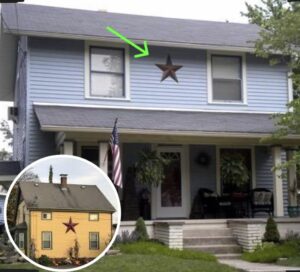Here’s What It Actually Means When You See a Star on a House

This story was originally reported in January 2021 and is being revisited due to renewed interest.
Back in late 2020, a viral social media post stirred up quite a bit of confusion by claiming that houses displaying five-pointed stars were secretly identifying themselves as homes of “swingers”—couples who engage in partner swapping. The claim spread quickly online, sparking speculation and even alarm in some communities. But after closer review, there’s no solid evidence to support this eyebrow-raising theory.
According to Distractify, the strange rumor appears to have started with a 2007 post on the StrippersOnline message board. Despite how quickly it resurfaced and spread on platforms like Facebook and TikTok, it’s little more than internet folklore.
So, what’s the real story behind these stars?
These five-pointed stars, usually made from metal and often displayed on barns or homes, are more traditionally known as barn stars or Amish barn stars. They’re most commonly found in regions with ties to the Pennsylvania Dutch—descendants of German-speaking immigrants who settled in areas like Pennsylvania and parts of the Midwest.
As reported by The Voice, a news outlet in Ontario, Canada, these stars are not mysterious or coded symbols. In fact, they’ve long been part of German-American folk art and are used to express cultural identity, tradition, and aesthetic charm.
A Morning Call article from Pennsylvania noted that interpretations of these stars may differ from one homeowner to another. However, they’re widely accepted as symbols of good luck and protection. Some even believe the color of the star adds extra meaning—such as black for strength or green for fertility and growth.
Search online and you’ll find barn stars for sale everywhere, especially in areas with a strong rural or Americana design influence. Their popularity is more about rustic charm and historical roots than anything remotely scandalous.
To be crystal clear: these stars are not a sign that someone is open to unconventional or non-monogamous relationships. Despite how intriguing social media theories might sound, they’re simply not grounded in fact.
Barn stars date back generations. They were originally used to ward off evil and promote good fortune. Rooted in German folk traditions, these decorations also connect to the use of hex signs—painted geometric designs meant to protect barns and bring blessings to farms. However, while hex signs carry deeper symbolic meanings tied to folklore, barn stars evolved to become more mainstream and purely decorative.
In today’s design world, barn stars are embraced far beyond Pennsylvania. They now show up on suburban homes, garden sheds, and even inside living rooms as part of farmhouse-themed décor. Their symmetrical, five-point design makes them a timeless symbol in American home styling.
Unfortunately, as is often the case with viral content, unfounded theories have tried to distort their meaning—turning innocent decorative items into something scandalous or conspiratorial. These modern myths often miss the rich cultural background of the objects they’re trying to reinterpret.
By understanding and appreciating the origins of barn stars, we help protect the value and story behind a meaningful tradition. Rather than getting caught up in online sensationalism, we should focus on the legacy these stars represent—home, family, luck, pride, and heritage.
So the next time you see one of these stars displayed proudly on someone’s porch or barn, know this: it’s not a secret signal. It’s a reflection of America’s diverse roots and the enduring beauty of its folk traditions. A simple star, rich with history, quietly telling a story that deserves to be respected—not reimagined through rumor.